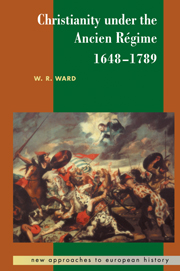Book contents
- Frontmatter
- Contents
- List of maps
- Preface
- Glossary
- 1 Peace and conflict: church and state in central and north-western Europe
- 2 Christianity in southern Europe
- 3 Catholicism in the Holy Roman Empire and the eastern Habsburg Lands
- 4 The religion of Protestants
- 5 Revival moves to the west
- 6 The Enlightenment and its precursors
- 7 The Churches in northern and eastern Europe
- 8 Religion after the Seven Years War
- Suggestions for further reading
- Index
- Title in the series
1 - Peace and conflict: church and state in central and north-western Europe
Published online by Cambridge University Press: 05 June 2012
- Frontmatter
- Contents
- List of maps
- Preface
- Glossary
- 1 Peace and conflict: church and state in central and north-western Europe
- 2 Christianity in southern Europe
- 3 Catholicism in the Holy Roman Empire and the eastern Habsburg Lands
- 4 The religion of Protestants
- 5 Revival moves to the west
- 6 The Enlightenment and its precursors
- 7 The Churches in northern and eastern Europe
- 8 Religion after the Seven Years War
- Suggestions for further reading
- Index
- Title in the series
Summary
Christian and non-Christian belief
In the middle of the seventeenth century religious belief and practice, by no means all of it Christian or confessionally organised, was interwoven with most aspects of life and was very difficult to escape. There were no doubt few who had Luther's vivid sense of the immediate and terrifying presence of God, but the time when a fine mystical soul like Gerhard Tersteegen (1697–1769), a slightly older contemporary of Wesley, could devote much of his ministry to assisting his fellows to ‘realize the presence of God’ (his most famous hymn in Wesley's translation begins ‘Lo! God is here, let us adore’) had not yet arrived. Many agricultural routines could be made to Wt to the church calendar; many guilds were in one aspect religious associations with their own saints, banners, altars and processions; and if life could hardly be lived without some practice of religious rituals, formal or informal, death, which God had in store for everyone, was the crown and test of all that had gone before. Like matrimony, death, the great reaper, was not to be undertaken lightly or wantonly.
Between birth and death, the European peoples, Catholic and Protestant, found authority driving the parish harder, and seeking to break up the congenial mixture of religion and magic which had sufficed in the later Middle Ages. To get rid, in the one case, of superstition, and in the other of Catholicism and superstition, required a continual clerical pressure which was something new.
- Type
- Chapter
- Information
- Christianity under the Ancien Régime, 1648–1789 , pp. 1 - 33Publisher: Cambridge University PressPrint publication year: 1999

